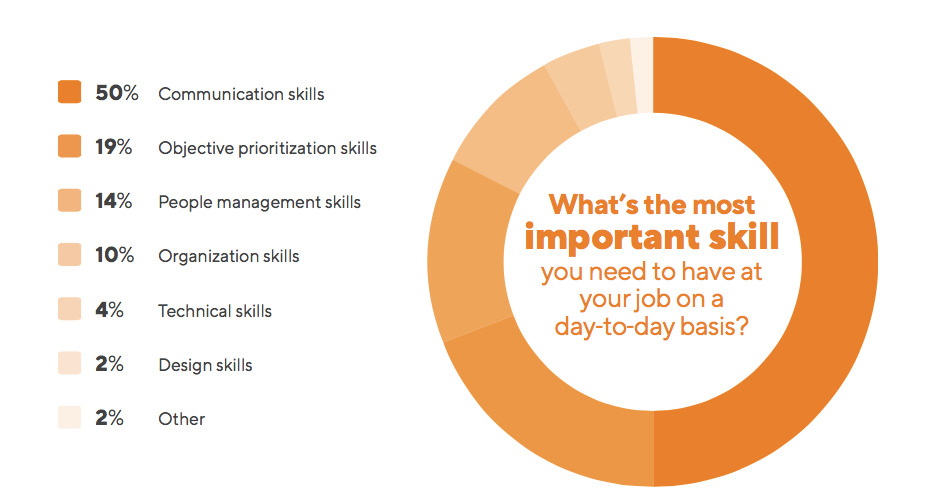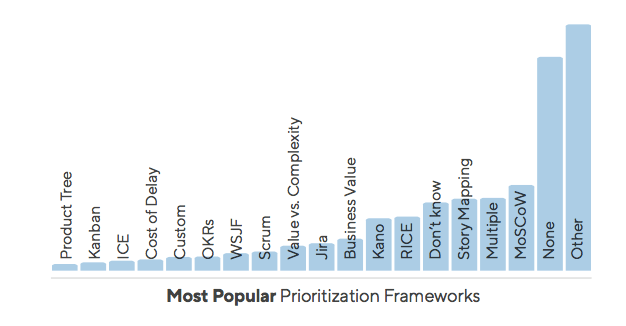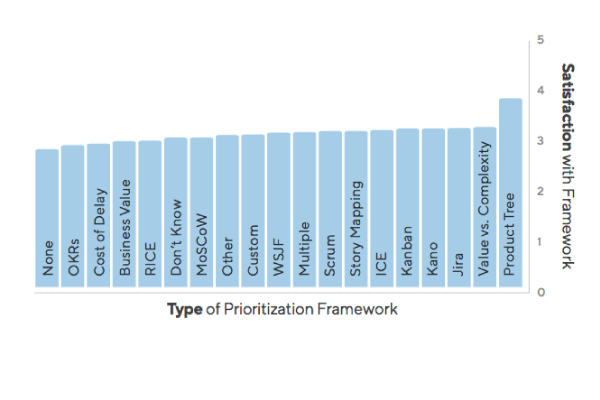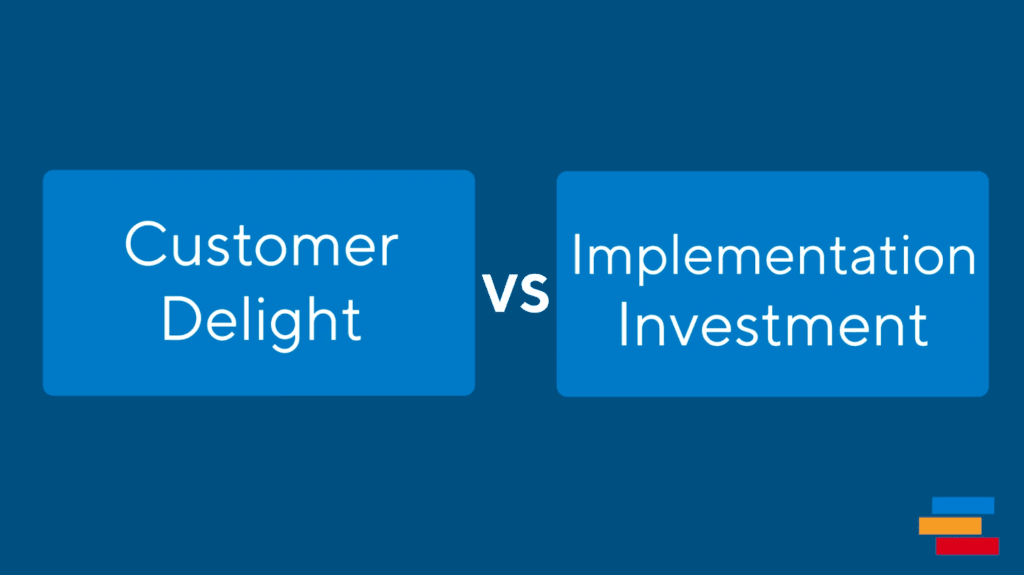The toughest part of product management might be prioritization. It’s where data and logic meet intuition and judgment. It’s easy to be wrong and hard to be right. Plus, it has to be done all the time! Whether it’s weekly or monthly, it is a regular task on the to-do list. Everyone’s going to be a fan of prioritization frameworks that simplify and streamline the process. That’s why it’s such a popular topic in the product management space. It’s always evolving as new trends catch fire, and old methods fall out of favor. So, what are the most popular prioritization frameworks of 2020?
In each edition of our annual product management survey (we just finished our sixth), we gain extra insights into what’s popular and trending. Prioritization ranked as the second most important skill for product managers behind communication.

We also discovered MoSCoW, Story Mapping, RICE, Kano, and using multiple frameworks were the most popular selections for prioritization. But the framework outclassing all the others in terms of users’ overall happiness with it was Product Tree, which notched a 3.8 out of 5 score.
Digging into the Most Popular Prioritization Frameworks
Popularity shouldn’t drive your choice of prioritization frameworks. But it can be a useful filter for deciding which backlog items are worth a closer look and potentially making the cut for the product roadmap. Based on our survey, these are the top trending frameworks product managers are using in 2020. Check them out and see if you’ve found a potential new favorite.

Product Tree
If something makes you happy, it doesn’t always mean it’s right for you (see: gorging on junk food while binge-watching Netflix). But a solution for a work task that makes you happy is likely also pretty useful. If it weren’t getting the job done, you wouldn’t be that happy about it!
That’s why Product Tree topping the charts for user happiness is such a good indicator of its merits. Although it’s not used nearly as often as other frameworks, it leads to the highest happiness ranking. Let’s take a closer look at why its cohort of devotees adores this framework.

Part of its appeal is the arts-and-crafts nature of a Product Tree exercise. People use markers and sticky notes to put virtual leaves (new ideas for features and functionality) on the branches (products or primary functions of a product), trunk (core functionality), and roots (infrastructure). It’s a highly visual experience that spawns productive conversations and debates.
The goal is to assemble a well-balanced tree, which is an eyeball test. Stakeholders can tell if they’re giving adequate attention to each critical area and providing incremental improvement across the product. It also offers sufficient weight for infrastructure and supporting technologies (are you building a robust enough root system to support the more massive tree), which often doesn’t get the focus they deserve.
Looking at the leaf placement can also help gauge if the product is growing fast enough to match growth targets. Plus, the game can be adjusted to look at other variables, such as ROI. This process makes it highly flexible for any environment.

MoSCoW
This weird-looking acronym is a fan favorite because it’s all about dropping items into one of four buckets:
- Must have
- Should have
- Could have
- Will not have (or wish it had)
Its power is in its simplicity. You must assign every item somewhere. This process forces some harsh realizations when examining a potential feature’s future worth to the product in such stark terms. Boiling things down to the essence of “how much do we need this” eliminates any uncertainty and fence-sitting.
And by evaluating each potential item discreetly, they’re appropriately weighed on their own merits. This way, they don’t get lumped in with other things and bypass the scrutiny they deserve.
Story Mapping
This prioritization framework is another excuse to get out of your craft supplies. What differentiates this method is its focus on user stories versus specific features and functionality.
Story Mapping is all about providing context for the user stories your product team is dealing with. You are literally bringing the customer journey to life by placing user stories in chronological order for a particular workstream.
This method is particularly useful for bundling related stories and identifying outliers. Those odd duck user stories must either be fully fleshed out (because they’re essential) or don’t warrant more attention (because they don’t fit into any of the significant workflows).
Story Mapping is excellent for finding holes in the customer journey where users might get frustrated. It’s also handy for building alignment and understanding among stakeholders of how different types of users are/will use the product. And since it’s a collaborative, iterative exercise, it engages the whole team.
RICE
The RICE Scoring Model is a more “traditional” prioritization framework. You score items up for consideration on four factors:
- Reach
- Impact
- Confidence
- Effort
This framework uses quite a bit of math compared to the other trending methods. But it does an excellent job of quantitatively evaluating the merits of each potential feature or enhancement.
When you finish, everything has a numerical score. The results can dictate (or at least influence) your prioritization decisions.
One of its shortcomings in comparison to other popular frameworks discussed here is that RICE doesn’t factor in any balance. So, for example, all three of the top-scoring initiatives might pertain to e-commerce. That means account management and logistics don’t get anything ranked at the top of the list.
But when it comes to apples-to-apples ROI calculation, RICE is excellent for determining what will give you the most bang for your buck. The benefits of such a definitive ranking system are why this method is a top pick for product managers.
Kano Model
The Kano Model distills prioritization down to two variables: benefit and cost. More specifically, increasing customer delight versus the cost to implement.

Features to be prioritized end up in three categories:
- Basic/threshold features—i.e., table stakes
- Performance features—the more you do, the happier the customer
- Excitement features—additions that yield a disproportionate amount of delight compared to their implementation cost
With everything slotted into one of these groups, it’s much easier to see where to expend development cycles. This model is best suited for earlier stage products where there’s limited time to make an impact and somewhat constrained resources. Think, “we just finished our MVP, now what?”
Another perk is that it identifies any features customers will be indifferent to, as well as any that might cause an adverse reaction — being able to spot and rule those out cuts down on the ones you have to prioritize.
Choose Your Own (Prioritization) Adventure
The frameworks above are just a sample of the many options product managers have to select from. And many teams use multiple frameworks, utilizing different methods for various situations or mixing things up periodically to get a fresh take.
Luckily there’s no “right” answer. It all comes down to preferences and what works for you and your organization.
But you’ll notice a common thread running through all these popular prioritization frameworks: they are collaborative in nature. Prioritization should be a group activity. Relying on frameworks that get everyone involved makes that easier.
Choosing the right framework to add to your current process—or choosing a replacement for an existing one—doesn’t have to be a hard decision to make.





